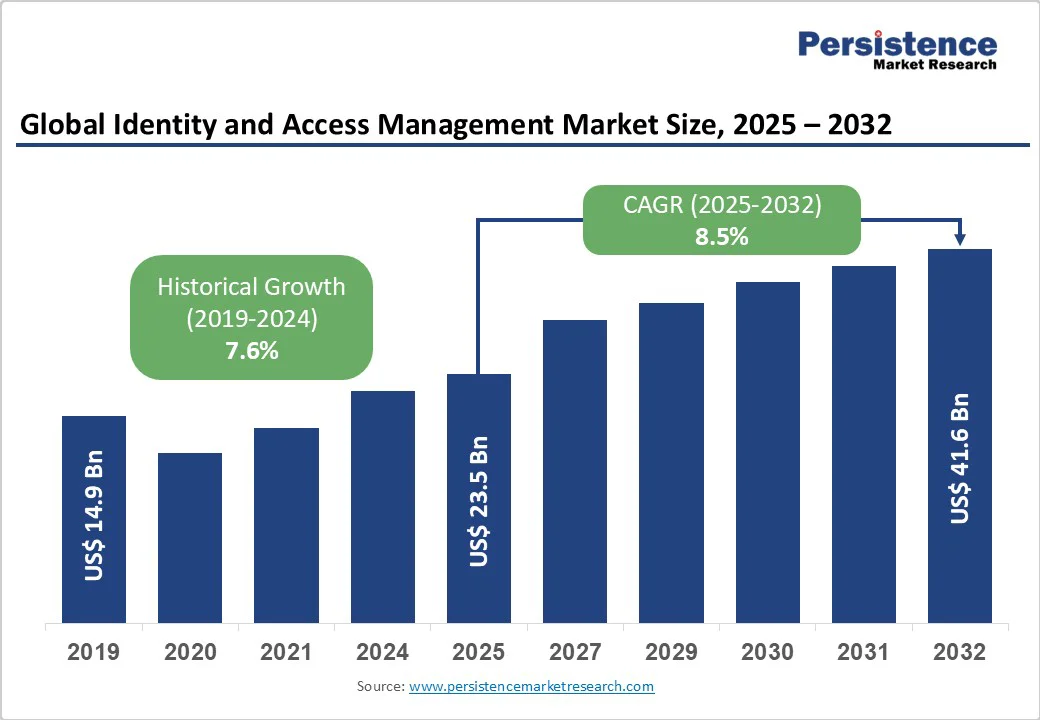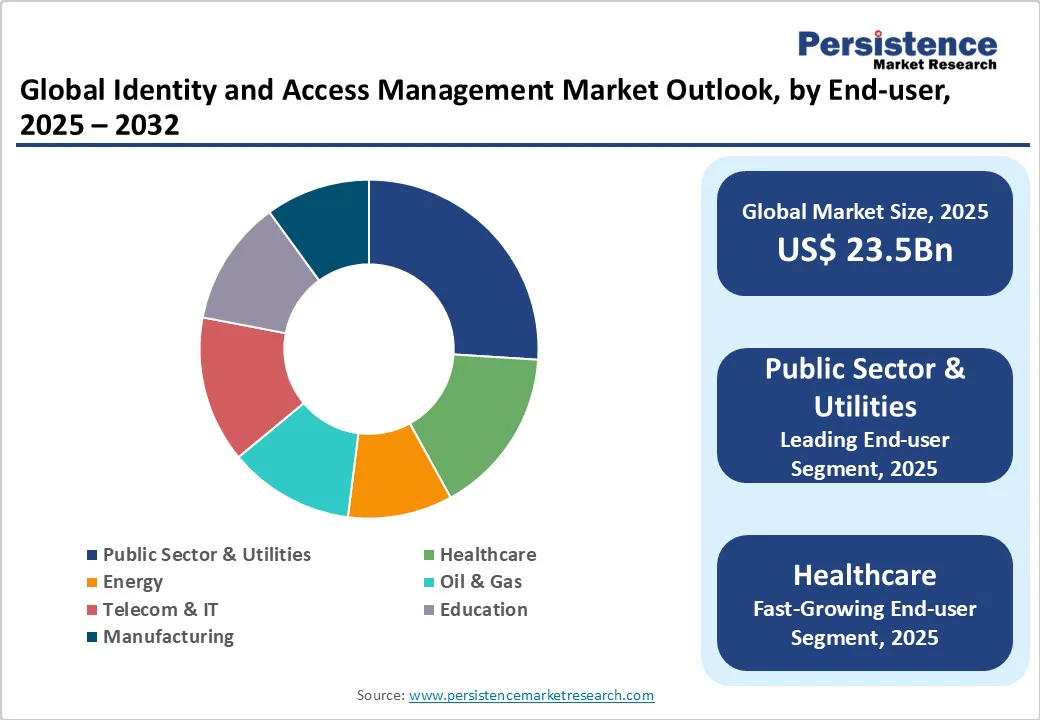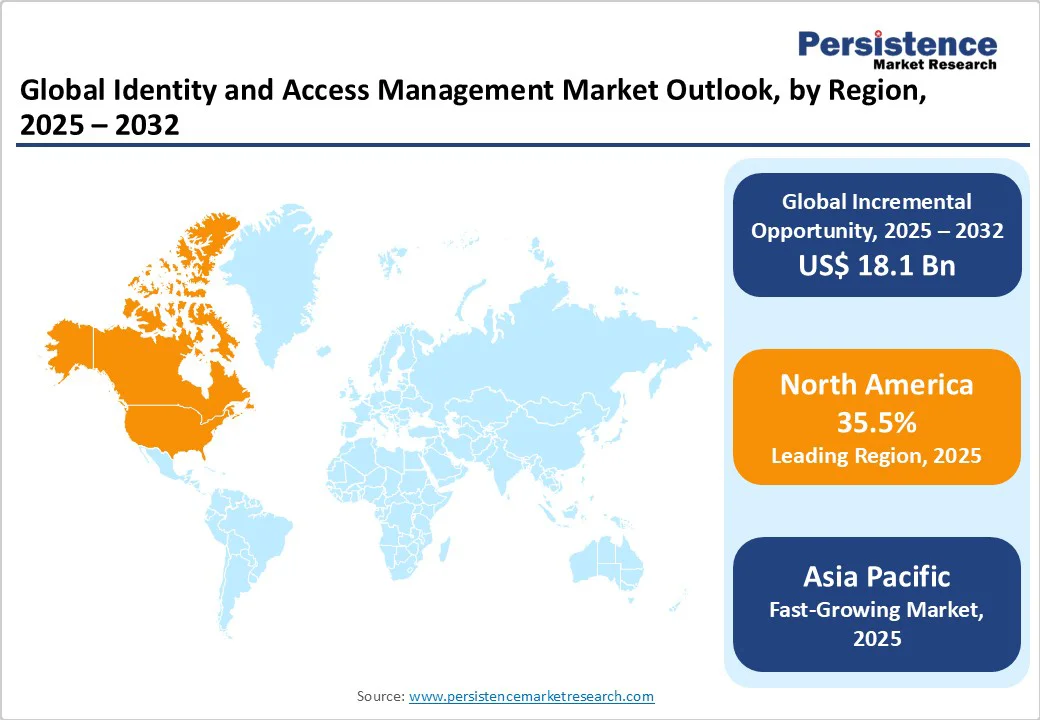ID: PMRREP9701| 187 Pages | 29 Sep 2025 | Format: PDF, Excel, PPT* | IT and Telecommunication

The global identity and access management market size is likely to value at US$23.5 Bn in 2025 and expected to reach US$41.6 Bn by 2032, registering a robust CAGR of 8.5% during the forecast period from 2025 to 2032, fueled by the increasing demand for secure digital identity solutions, advancements in authentication technologies, and a global push toward enhancing cybersecurity infrastructure and compliance.
| Key Insights | Details |
|---|---|
|
Identity and Access Management Market Size (2025E) |
US$23.5 Bn |
|
Market Value Forecast (2032F) |
US$41.6 Bn |
|
Projected Growth (CAGR 2025 to 2032) |
8.5% |
|
Historical Market Growth (CAGR 2019 to 2024) |
7.9% |

The global surge in demand for robust cybersecurity is a primary driver of the identity and access management market. According to research, cybercrime damages are projected to reach $10.5 trillion annually by the end of 2025, with the technology enabling ultra-reliable identity verification essential for zero-trust architectures and remote work ecosystems.
The rising frequency of data breaches and identity theft is significantly driving the demand for identity and access management (IAM) solutions. With organizations becoming increasingly dependent on digital platforms and cloud-based networks, the risks of unauthorized access and data exposure are growing, creating a global security burden. To mitigate these threats, governments and enterprises are accelerating investments in IAM infrastructure.
The United States is at the forefront, adopting multifactor authentication to strengthen regulatory compliance, while Europe is enhancing security standards through initiatives such as the EU’s NIS2 Directive, which complements GDPR enforcement by emphasizing identity-centric safeguards.
The telecom and IT sector accounts for a major portion of security expenditure and is embracing IAM technologies to address vulnerabilities tied to cloud adoption and complex access requirements. The rise of data-intensive applications is amplifying the need for advanced solutions that ensure reliable performance and security.
High costs associated with implementing comprehensive IAM systems pose a significant restraint to market growth. Enterprises, particularly small and medium-sized ones, face budgetary constraints in deploying advanced IAM solutions that require integration with existing IT infrastructures. Additionally, the complexity of customizing IAM platforms to meet diverse organizational needs increases overall expenses. Stringent regulatory compliance requirements, such as GDPR in Europe and CCPA in the US, add layers of complexity and cost, as non-compliance can result in hefty fines. The lack of standardized identity protocols across industries further complicates adoption, leading to interoperability issues and delayed implementations. These factors collectively hinder widespread market penetration, especially in cost-sensitive regions.
The ongoing need for continuous updates and maintenance to counter evolving threats exacerbates the financial burden, deterring smaller players from entering or scaling up in the identity and access management market. Supply chain disruptions in hardware components for multifactor authentication devices also contribute to volatile pricing, further straining adoption rates in developing economies.
Legacy system integration challenges, particularly in sectors such as manufacturing with outdated IT setups, compound these issues, often requiring extensive consulting services that inflate project timelines and budgets. As a result, many organizations opt for piecemeal solutions over holistic IAM deployments, limiting the identity and access management market's full potential realization.
Opportunities in the identity and access management (IAM) market are expanding rapidly, driven by advances in artificial intelligence and machine learning that enable adaptive authentication and more secure user verification. The acceleration of e-commerce and digital services has created a strong need for seamless yet safe access, opening avenues for biometric and passwordless login solutions. Blockchain technology is also emerging as a transformative force, offering decentralized identity management with particular applications in sectors such as healthcare and financial services.
The shift toward hybrid work environments further strengthens the demand for scalable, cloud-based IAM platforms. Vendors providing modular, API-driven systems that integrate efficiently with SaaS applications are well positioned to benefit. At the same time, privacy-enhancing technologies, including homomorphic encryption, are becoming essential for secure data sharing without exposing sensitive information, aligning with the strict requirements of regions such as the European Union.
Emerging ecosystems such as the metaverse and Web3 are also fueling demand for advanced IAM frameworks capable of managing virtual identities. Meanwhile, public sector digitization in developing markets creates fertile ground for cost-effective IAM solutions tailored to government needs, fostering long-term partnerships and recurring revenues. Together, these dynamics position IAM as a cornerstone of future cybersecurity growth.
The identity and access management market is segmented into audit, compliance & governance, directory service, multifactor authentication, provisioning, password management, and single sign-on. Provisioning dominates, holding approximately 38% of market share in 2025, due to its proven efficacy in user lifecycle management, high automation potential, and integration into standard identity protocols. Provisioning solutions are widely used in enterprise IT, offering automated role-based access that reduces administrative overhead.
Multifactor authentication is the fastest-growing segment, driven by increasing demand for layered security in cloud environments. Multifactor authentication offers versatile deployment as targeted options, with advancements in biometrics and tokenization making them suitable for long-term use in high-risk populations.
The identity and access management market is segmented into cloud, hybrid, and on-premise. Cloud dominates, holding approximately 38% share in 2025, due to its balance of scalability and cost-efficiency, precise integration delivery, and adoption into standard enterprise regimens. Cloud deployments are widely used in dynamic organizations, offering reliability that reduces downtime.
Hybrid is the fastest-growing segment, driven by increasing demand for flexible architectures in regulated industries. Hybrid provides ultra-high customization as advanced configurations, with advancements in federation tech and policy enforcement making them suitable for long-term use in compliance-heavy sectors.
The identity and access management market is segmented into energy, oil & gas, telecom & IT, education, healthcare, public sector & utilities, manufacturing, and others. Public Sector & Utilities holds approximately 36% share in 2025, due to their proven efficacy in secure governance, capacity support, and integration into digital protocols. Public Sector & Utilities are widely used in government networks, offering access controls that reduce breach risks.
Healthcare is the fastest-growing industry, driven by increasing demand for patient data protection in digital health records. These applications provide reliable safeguards as core systems, with advancements in consent management and encryption making them suitable for long-term use in sensitive populations.

North America dominates the global identity and access management market, expected to account for 35.5% of market share in 2025, driven by a robust cybersecurity ecosystem, high infrastructure investments, and a cultural emphasis on digital connectivity and innovation. The United States, as the regional market leader, benefits from stringent regulations such as HIPAA and SOX that mandate the adoption of advanced identity and access management (IAM) solutions across industries. Growth is fueled by the widespread use of cloud platforms, with major providers driving demand for sophisticated identity federation.
Enterprises in finance and technology hubs are leading investments in zero-trust frameworks to address complex cyber threats, while government initiatives such as CISA’s zero-trust maturity model further accelerate public sector adoption. The region’s mature startup ecosystem also nurtures innovation in areas such as passwordless authentication, strengthening the competitive landscape. Despite this progress, challenges remain, particularly a shortage of skilled IAM professionals, which has increased reliance on managed services. Overall, North America’s regulatory maturity, innovative ecosystem, and tech-savvy consumer base position it as the global hub for IAM evolution.
Europe represents a mature yet evolving in identity and access management (IAM) market, with countries such as Germany, the UK, and France spearheading growth under stringent data protection frameworks. Germany’s Industry 4.0 initiatives are accelerating IAM adoption in manufacturing by emphasizing secure IoT integrations, while the UK’s post-Brexit digital strategy prioritizes sovereign identity solutions to strengthen economic resilience. France is advancing public sector digitization through FranceConnect, a national IAM platform that underscores the region’s commitment to interoperability and citizen-centric services.
Key drivers include the far-reaching impact of GDPR, which continues to encourage proactive IAM investments, and the EU’s Digital Services Act, which supports opportunities in cross-border data flows and federated identity models. Nordic countries such as Sweden are gaining attention for integrating sustainable IAM practices into green data centers, aligning with EU Green Deal objectives. Despite opportunities, challenges remain due to fragmented national regulations. However, collaborative projects such as the European Blockchain Services Infrastructure are paving the way for decentralized identities. Overall, Europe’s IAM market balances innovation and regulatory compliance, positioning the region for above-average long-term growth.
Asia Pacific is emerging as the fastest-growing region in the identity and access management (IAM) market, supported by rapid digitalization and rising internet penetration across China, India, and Japan. China’s national cybersecurity law is propelling IAM adoption in public services, securing smart city infrastructure and connected ecosystems. India’s Digital India initiative mandates IAM integration for e-governance platforms, creating large-scale demand for scalable provisioning solutions. Japan is advancing hybrid deployments in healthcare, leveraging biometrics to enable secure telehealth for its aging population.
The region’s booming e-commerce sector is driving strong demand for single sign-on and passwordless authentication to ensure seamless user experiences. Government investments, such as Singapore’s Smart Nation program, highlight a regional focus on zero-trust security frameworks. While varying data sovereignty laws present challenges, collaborative efforts such as ASEAN’s digital economy framework are encouraging standardized IAM protocols. With a young, tech-savvy demographic and growing cloud adoption, Asia Pacific is well-positioned for robust growth, with opportunities in AI-driven fraud detection supporting the fintech sector.

The global identity and access management (IAM) market is highly competitive, with leading international and regional players focusing on innovation, advanced security features, and seamless integration capabilities. The growing adoption of AI-driven authentication, zero-trust frameworks, and cloud-based solutions has intensified rivalry, compelling companies to address diverse enterprise requirements. Strategic partnerships, acquisitions, and compliance with stringent privacy and security standards are becoming key differentiators shaping market leadership.
The identity and access management market is projected to reach US$23.5 Bn in 2025.
Rising demand for high-speed connectivity, technological advancements in designs, and government initiatives for networks are key drivers.
The identity and access management market is poised to witness a CAGR of 8.5% from 2025 to 2032.
Innovations in mmWave sourcing and multi-application designs, such as targeted links, present significant growth opportunities.
Amazon Web Services, Inc., Broadcom, One Identity LLC., ForgeRock, HID Global Corp., IBM, McAfee, LLC, Microsoft, Okta, OneLogin, Oracle, Ping Identity, SecureAuth, and Evidian are among the leading players, known for their innovative antenna solutions.
| Report Attribute | Details |
|---|---|
|
Historical Data/Actuals |
2019 - 2024 |
|
Forecast Period |
2025 - 2032 |
|
Market Analysis |
Value: US$ Bn Volume: As Applicable |
|
Geographical Coverage |
|
|
Segmental Coverage |
|
|
Competitive Analysis |
|
|
Report Highlights |
|
By Component Type
By Deployment
By End-user
By Region
Delivery Timelines
For more information on this report and its delivery timelines please get in touch with our sales team.
About Author